The headline in the SMH was
Australia’s energy operator proposes ‘fast change’ scenario to cut emissions by 52 per cent by 2030
followed by:
-
Greenhouse gas emissions from the electricity sector would be reduced at twice the rate proposed by the Turnbull government under a radical new plan outlined by the Australian Energy Market Operator.
The “fast change” model puts the public operator on a collision course with policymakers after AEMO outlined a potential cut of 52 per cent to all electricity emissions by 2030, double the rate required to meet our Paris climate change commitments.
The bit I’ve highlighted was wrong. AEMO charted a doable scenario double the rate specified by the Turnbull government, but it was derived from the ENA CSIRO Low Emissions Technology Roadmap, which looked at what would be required to meet the 2°C target under the Paris Agreement. AEMO says ENA and CSIRO:
- found that for the broader energy sector to meet a proportional target of 26-28% emissions reduction by 2030, electricity sector emissions may have to reduce by 52-70% by 2030 and 90% by 2050. AEMO intends to apply an emissions reduction constraint of 52% by 2030 and 90% by 2050 in the Fast Change scenario for the ISP [that is, the Integrated System Plan].
In other words, AEMO is looking at what the government should be doing as well as what it is doing, thus showing commendable independence.
To back up, AEMO is developing an Integrated System Plan for the NEM which arose from two sources. Firstly, the Finkel Review said AEMO:
- should develop an integrated grid plan to facilitate the efficient development and connection of renewable energy zones across the National Electricity Market.
And secondly, AEMO would normally do a National Transmission Network Development Plan (NTNDP) for the Australian Energy Regulator (AER).
It has wrapped both into one to develop a nationally integrated strategic plan which takes into account the challenges and opportunities facing the grid during the transition to renewable energy. The consultation draft (linked above) was published in December 2017, which evoked a number of submissions. The final is to be published in June 2018.
The aim was to identify renewable energy zones (REZ) and how they might best be linked.
It assumes that new generation will be mostly wind and solar PV, with pumped hydro and/or batteries for storage. It considers some geothermal but appears to neglect concentrated solar with molten salt. It notes that the new technologies are cheaper and amount to about 82% (representing about 19 GW of capacity) of new generation projects in development (the remainder is mostly GPG projects).
These new projects are likely to be located some distance from existing generators.
They show an interesting pattern of how the wind blows over 24 hours in the various NEM states, with an overall profile of solar:
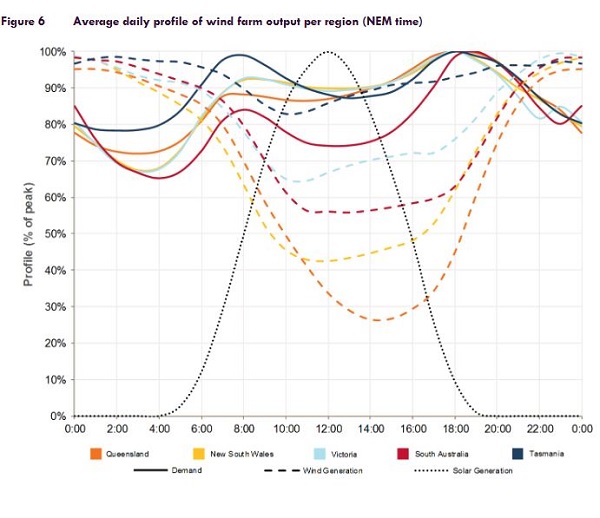
Of interest, I heard recently that global average winds have been slowing down, apparently as much as about 20 per cent since the 1970’s, they thought because wind depends on temperature difference, which is evening out.
The other big driver is the closure of aging coal. This image shows the expected closure of plants when they reach 50 or have been announced to close earlier:
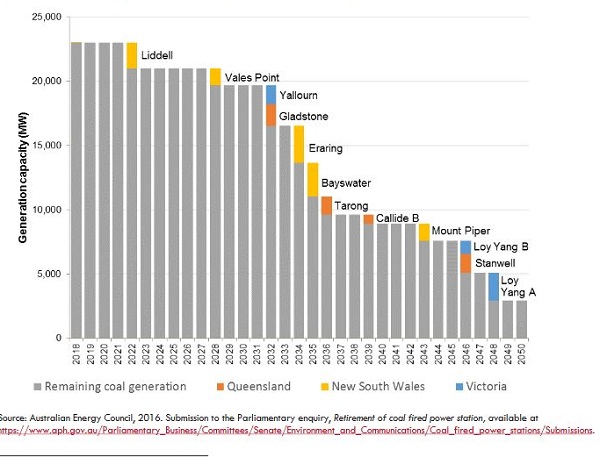
AEMO decided on doing three scenarios – business as usual, bookended by ‘slow change’ and ‘fast change’ alternatives. The difference in the rationale between BAU and slow change is not clear to me, but the Queensland and Victorian 2030 targets are not included beyond 2020, I think because they don’t have bipartisan support. In the summary of submissions they have introduced the concept of a ‘high DER’ scenario. DER equals ‘distributed energy resources’.
In forward planning the period from 2030 to 2036-37 has significance, because ~10 GW of coal generation is projected to retire. Here is the generation mix capacity to 2036-37 under a “neutral” scenario:
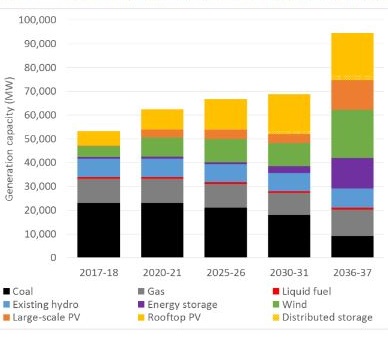
which is markedly different from projected output:
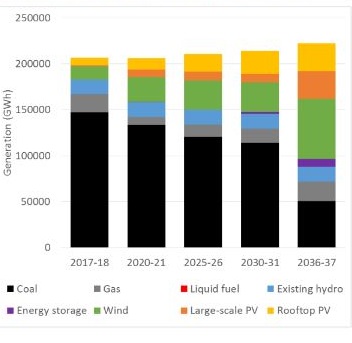
Energy storage only becomes prominent after 2030.
Transgrid in their Stage Two Submission saw an even stronger role for rooftop PV:
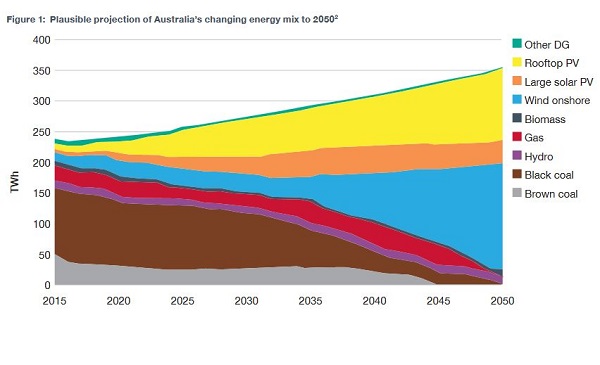
That graph was sourced from Energy Networks Australia and CSIRO: Electricity Network Transformation Roadmap.
There is general agreement, however, that the future will bring an emphasis on distributed energy resources (DER).
In plotting renewable energy zones they looked at where the wind and solar resources are:
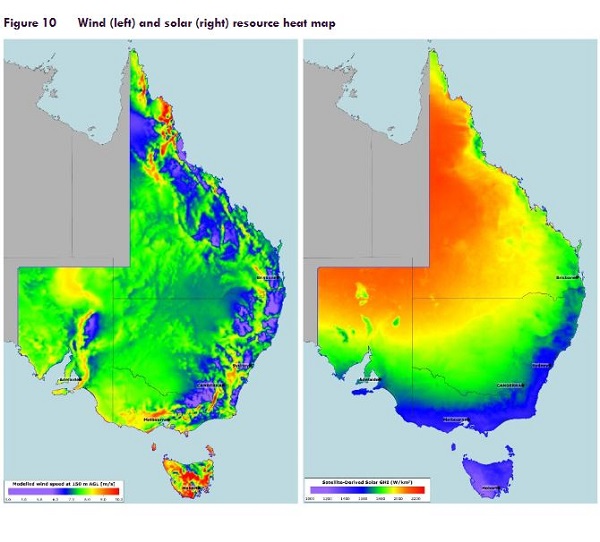
where the pumped hydro sites are:
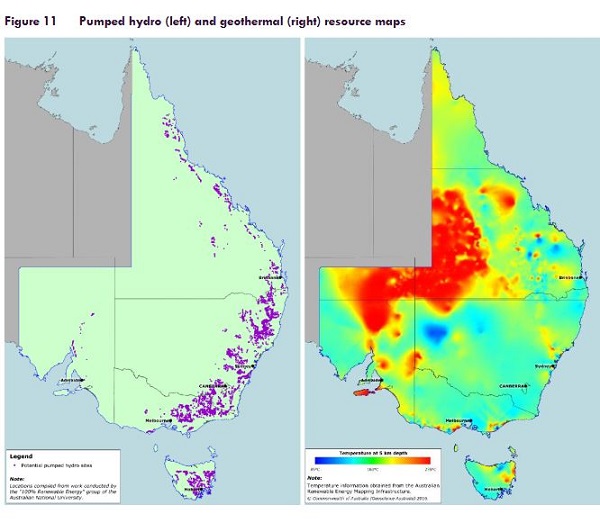
and then scored wind and solar using a variety of criteria, including distance from customers, topography, land availability, transport service etc. to come up with this:
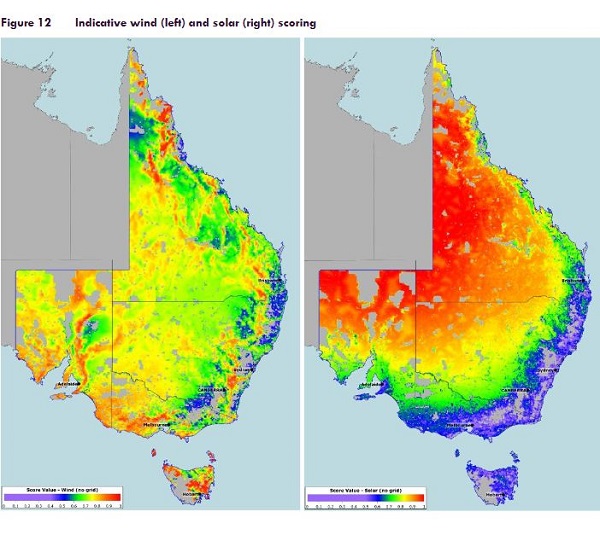
Finally, they identified renewable energy zones:
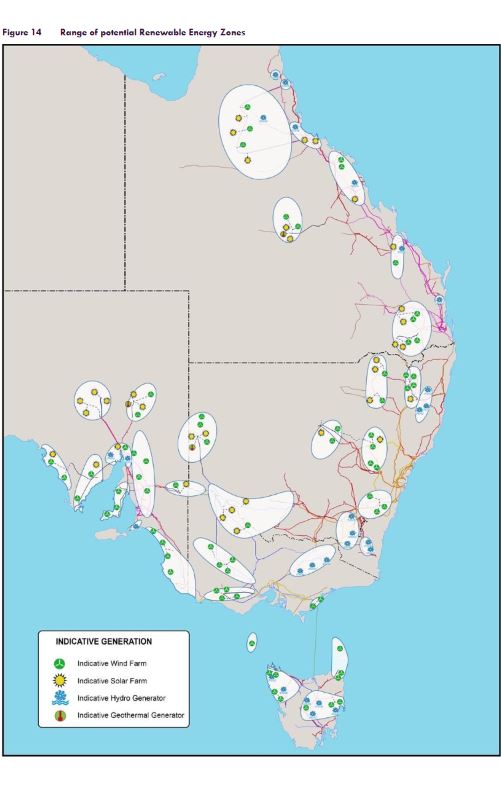
Thing is that when you look at system strength, things are a bit stretched in places, especially northern Queensland and western Victoria and SA outside Adelaide:
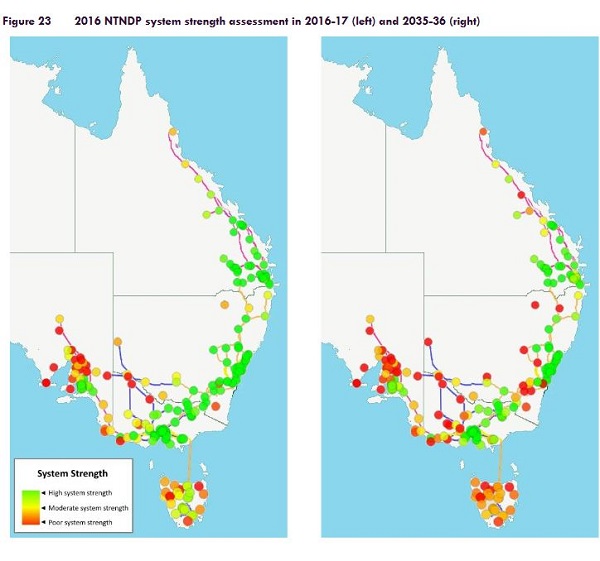
Powerlink in their submission mentioned the chicken and egg problem. Should transmission companies build in anticipation of renewable energy developments? If the power is not there it takes a brave developer to go out alone. But restricting new developments to places where there is grid access means some of the best sites will go begging.
- Major transmission investment can be achieved at lowest cost due to economies of scale. For example, the cost of installing a 500 kV transmission line to connect a new renewable energy zone is around double the cost of a 330 kV line, but delivers around three times the capacity.
Powerlink wanted AEMO to publish the MLF (“marginal loss factor”) for each REZ. This is a serious issue, and relates to the loss of power between where it is generated and where it is used. AEMO has just slashed the output calculations for a range of wind and solar farms especially in north Queensland, in western NSW and Victoria. Many projects have suffered cuts of between 10 and 22 per cent.
Transgrid looked at the prospect of 8000 MW of coal shutting down in NSW by 2036. Trangrid have had enquiries amounting to around 30,000 MW of prospective new power generation interested in grid connection. They say (para 1.2):
-
Distributed Energy Resources (DER) will play a growing role in Australian energy markets. Australia already has some of the highest rates of rooftop solar PV penetration globally, and as technology costs continue to decline, uptake of solar, energy storage and other behind-the-meter technologies will continue to grow. In the Electricity Network Transformation Roadmap, Energy Networks Australia and CSIRO forecast that by 2050 around 30-50% of electricity generation could be sourced from DER under some scenarios (up from about 3% currently).
Also:
- even in a scenario with high DER uptake, the volume of electricity supplied from large-scale generation and delivered via the transmission and distribution networks does not decline.
Trangrid looked at potential generation zones in relation to where the enquiries were coming from, and came up with this:
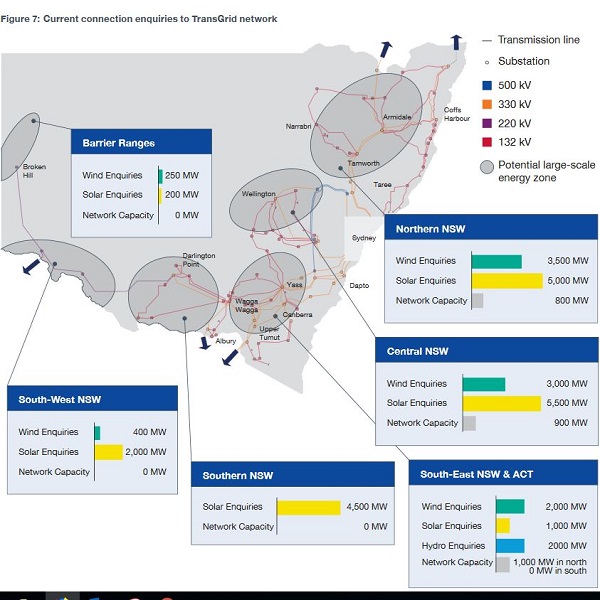
The zones have the potential for in total 65 GW of high quality generation. The future does not need to be parsimonious in use of power. Please note they see two interconnectors north to Queensland and three south to Victoria.
All that would seem to be encouraging, but in the AFR we had Danny Price attacks AEMO’s Audrey Zibelman over ‘power grab’.
- He said “the fact that one of the key NEM (National Electricity Market) organisations feels it appropriate to make such an audacious, public grab for power” ought to alarm investors and “any right thinking policy makers that may be left in government about what is happening to a key NEM institution”.
He wants her dismissed immediately. Seems he may not understand that she was only doing what was asked of her. Leaving aside Snowy 2.0, the states are responsible for electricity systems. Perhaps her sin was to suggest that the fast track could be taken by reverse auctions, as has already happened in SA, ACT, Qld and Victoria to good effect. Her mortal sin was probably no mention of a carbon tax, which then leaves it to the market to pace change. AEMO has shown the possibility of states using their brains to shape the market, and speed it up in a coordinated way.
I think this exercise has also shown that the planning horizon needs to go beyond 2030.
Also, the notion that the future will be, in the main, decentralised solar and wind, with Transgrid repeating the levelised projected costs of generation:
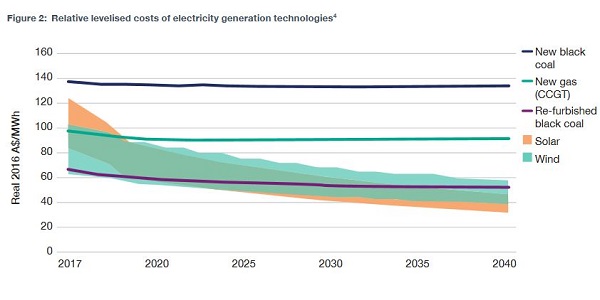
Apart from propping up coal looking like a real option in terms of cost, we need to remember that generation only forms 20 to 25 per cent of the customer’s power bill while the network accounts for 50 per cent or more. I plan to look at this in my next major climate post, but no-one I know is doing forward projections.
For the full AEMO consultation paper see Integrated System Plan (ISP) for the NEM.


Brian,
Yesterday, I attended as an observer, a public hearing conducted by the NSW Parliament Legislative Council (Upper House) Select Committee on Electricity Supply, Demand and Prices in NSW, at NSW Parliament House, link to inquiry webpage here.
I made a similar comment to one of the Committee members in passing during a break in proceedings and he acknowledged that generator prices get all the attention for relatively little contribution to the consumer bills, or words to that effect.
One of the witnesses, from my memory (transcript not available yet), made the point that deep emissions reductions in the electricity generation sector is relatively easier to achieve when compared with the transport sector and industry. Therefore, more ambitious targets need to be set for the electricity sector to compensate for the other sectors (where it is likely be harder to achieve similar emissions reductions) to achieve an overall reduction in emissions across sectors combined.
I arrived approximately halfway through the testimony given by representatives of Origin Energy and Energy Australia, but one of the questions I heard asked was what Origin and Energy Australia considered was an acceptable notice period prior to closing a generator – answers 5 and 3 years. It’s interesting to note that it requires more than 5 years to build a new coal-fired power station. So, it seems renewables are the only technologies options available for short notice generator closures, particularly 3 years notice.
Usually NSW Hansard is fairly quick to provide a draft transcript, which will probably be available later this week. Lots of good questions and answers – encouraging.
Brian,
The image shown in your post above of the expected closure of coal-fired plants when they reach 50 or have been announced to close earlier (it appears sourced from the Australian Energy Council, 2016) does not consider potential coal supply issues.
At the Australian Senate inquiry into the Retirement of coal fired power stations public hearing in Melbourne, on 17 November 2016, from the hearing transcript on page 19, with Mr Mark Collette, Executive Energy, EnergyAustralia:
Note the words: “depends on what energy and climate policy looks like” in the 2020s. So, Yallourn W could close in 2026 if the coal licence is not extended out to 2032.
Then, there is Mt Piper power station, currently solely dependent on coal supplies from Springvale underground coal mine. From Centennial Coal’s Statement of Environmental Effects: Springvale Mine Extension Project SSD 6694 Modification 1: Volume 1: Main Report document, dated July 2016, Section 4.2.3 Coal Production Rate includes (bold text my emphasis):
Modification 1 was approved on 19 April 2017 and Springvale mine’s extraction rate has increased up to 5.5 Mt/y maximum, so it looks reasonably certain to me that Springvale mine will be exhausted by around 2024. Angus Place mine (also controlled by Centennial Coal) is the only other nearby mine with the capacity (4 Mt/y) to fully supply Mt Piper’s needs (via a private road link), but its development consent expires in August 2024 – surprise, surprise. And even if Angus Place does gain an extension to extract coal beyond 2024, there are some indicators to suggest that Angus Place does not have sufficient coal reserves to supply Mt Piper to 2043, meaning coal would need to be sourced significantly further away at greater expense, or Mt Piper closes earlier. Airly mine, at 1.8 Mt/y maximum extraction rate, expires in 2035. Clarence mine (3 Mt/y maximum) expires at the end of 2026.
These are the coal supply issues I’m aware of. There may be more that may influence earlier closures.
On a separate issue, the NSW Government published its Submission AEMO’s Integrated System Plan, dated March 2018, where it highlights three potential priority energy zones in NSW (shown in Figure 1) as:
New England Energy Zone, centred about Armidale;
Central West Energy Zone, centred about Dubbo; and
South West Energy Zone, centred about Hay.
Brian,
An interesting omission.
The Uncorrected Transcript of yesterday’s public hearing (referred in my comment at MAY 9, 2018 AT 1:42 PM) is now available, link here.
After Professor Martin Green had finished his testimony, I had the opportunity to speak briefly with him outside the hearing room. I asked him where he saw solar thermal with storage fitted in with the renewable energy mix for dispatchable supply and he suggested it was not competitive with wind and solar plus PHES with interconnectors. When I said that the South Australian project Aurora was reportedly contracted to supply electricity at no more than $78/MWh, he appeared to me to be genuinely surprised by that figure, and suggested it was an aberration, or words to that effect.
I also queried him on his testimony regarding CST not being modular. In the transcript on page 22, (bold text my emphasis):
Professor Green’s testimony conflicts with BZE’s Stationary Energy Plan 2010 stated intention of modular design of CST to minimize design and construction costs.
I don’t doubt Professor Green’s expertise on solar-PV, but I wonder whether his understanding of solar thermal with storage is currently up to date. Other than this aspect, I thought Professor Green provided an interesting and informative testimony.
Geoff M
The vast majority of home or factory roofs in Australia are planar. Often the building is aligned East-West so half the roofing faces roughly North. The solar panels are small relative to roof dimensions, so they can be “packed in” with a planar array.
I mean the lowest cost, fixed orientation that most homes and businesses use. Static. Possibly tilted to an optimum angle above the roof slope. But not systems using dynamic ‘tracking’ to maintain orientation exactly sunwards during daylight.
So the points about that product being sufficiently adaptable to most requirements seems valid.
For largescale setups, every site is different, si?
Might need some bulldozing, might need to consider wind damage? Certainly need very precise aiming of every mirror.
It’s interesting how relative costs and efficiencies change over decades and sometimes shorter timescales.
+++
BTW: Yallourn coal is under the control of the State of Victoria. While the Govt encourages renewable energy installation, I haven’t heard anyone suggest they might cut off coal supplies to the Yallourn power station after 2026.
But the future is very hard to predict.
Ambi, I believe you lose 12 per cent with east facing solar panels as compared with north. Our panels face just north of east.
Geoff M, every time I look now at the NEM, NSW seems to be importing power. Qld is always exporting it. SA does sometimes now too, and Victoria, sometimes exporting and sometimes importing, but with Brown coal permanently ramped up to a fairly high level.
You’ve shown that NSW may be less favourably placed than the AEMO plan shows, but there seems to be quite a lot of new energy proposals around.
What I find alarming is this in the NSW Govt submission:
Then later this:
They don’t seem to see that AEMO is helping them, not the other way around. They should be doing something to make things happen, not just regulate land use according to needs for farming, biodiversity and heritage, which seems to be how they see their role.
GM: As far as I know brown coal is mined by bucket wheel excavators that feed on to a conveyor system that runs all the way to the power station. Not sure how easy it would be to bring coal from further away although there are some very long conveyors used in parts of the world.
Some black coal power stations are fed direct from the mine but others are connected by rail.
Given that a lot of Aus thermal coal is exported I can’t see any valid reason why a power station cannot be kept going by cola that can be railed by some distance away. Yes it will cost more but the xtra cost is unlikely to be overwhelming assuming the rail line and coal handling facility is already there.
Curious to know why solar thermal with molten salt heat storage and back-up salt heating didn’t get a mention. It is a logical part of a reliable system.
Thanks for your lucid article, Brian, at to all for your worthwhile comments – quite a nice change from the conversations I have heard of late around this little corner of the Clever Country.
All attention is on the production of energy (mainly electricity) and very little at all is on consumption. Sadly, it cannot be any other way – because the producers of electricity and of fossil fuels are paid for what they sell – and the more they sell, the more they are paid – there are powerful financial incentives to keep all discussion on the subject as narrow as it is.
But what if robust discussion were focused on consumption for a short while? I don’t mean just on ClimatePlus, (you’re doing fine), but throughout the wider community.
On transport: Nobody today dares mention the British fuel-saving slogan from the Second World war, “Is your journey really necessary?” Ride-sharing, once fairly common among neighbours and workmates, now has social and insurance disincentives. It generally takes more energy to move more mass, so why the blazes are we marooned in the 1930s and 1940s when it comes to moving goods, despite all the advances in technology since then?
In the home: Why do we continue allow the horribly inefficient muck-mansions to be built and sold when so many of the alternatives are far more efficient, far more suited to our actual needs, far more comfortable, far cheaper, far less demanding of non-renewable materials? (And they’re usually far prettier and safer too). The concept of food-miles appeared for a short time, then vanished – yet this concept is valuable in finding ways of reducing energy demand. Clothing is another area where demand for energy and non-renewable resources can be lowered but all the social and economic pressures are to maximize squandering money on clothing of doubtful value and durability (and mostly poor style too).
The list goes on and on.
The bottom line, for me, is that I would rather see the economy collapse than see the planet collapse. But – with wisdom and courage, we can have both a vibrant economy AND a recovering planet.
Brian at 10.42pm (sic)
Yes, I like to think of it as the “forgiving nature of the cosine function”.
If you will allow me a moment or two.
Power received is proportional to the cosine of £ where £ is the angle between the line to the Sun and the “normal ” to the flat (plane) collector.
[Apologies. The “normal” is any line perpendicular to the flat collector surface.]
The graph of cos (£) has its maximum when £ = 0, perfect alignment. But for small angles, say £ = 10 degrees, 20 degrees, cos (£) is still not very far below 1.0000, its maximum possible value.
Even with £ = 45 degrees, cos (£) has only dropped to about 0.707 or
1/[sqrt (2)] ,
so we are still catching almost 71% of the available power. And that’s poor alignment, halfway in angle to minimum “alignment” when £ = 90.
So it’s understandable that flat collectors can still do a mighty job even if they’re fixed in place, and even if facing north-east or north-west.
Here endeth the digression//
Cosine Rules!!!
Graham Bell
That’s a very good list. Worthy of many discussions. I see only small progress on some, a little better-than-small on others.
10.24pm actually.
good on you Brian.
Ambi
of the Cosinus.
Ambigulous (Re: MAY 9, 2018 AT 7:15 PM):
Have I said anywhere in my comments that I was disputing Professor Green’s testimony that solar-PV was adaptable to most requirements?
My dispute is concerning Professor Green’s apparent dismissal of solar thermal technology. You seem to have missed my comment above:
I think it would be unwise to dismiss solar thermal technology so quickly.
The perception I gained from my brief conversation with Professor Green after his testimony was that he appeared to be not up to date with latest reported MWh costs for South Australia’s project Aurora. My question/concern is whether his testimony was based upon non-current, out-of-date information regarding solar thermal.
Solar thermal with storage is ‘dispatchable’ primary energy with a capacity factor up to 70% possible, all in the one package.
Solar-PV, although a primary energy source, is not dispatchable without battery or PHES added, and at best has a capacity factor of about 30%.
Brian (Re: MAY 9, 2018 AT 10:24 PM):
And you were questioning me a few weeks ago why I was concerned about electricity supply. It seems you may be coming around to understanding my concerns.
John Davidson (Re: MAY 9, 2018 AT 10:31 PM):
Just because it can be done, doesn’t mean we should continue to do it. Should we be continuing to mine and burn coal, and continue to operate coal-fired and gas-fired power stations? David Spratt says per some highlighted research:
ANU Professor Steven Blakers video from time interval 08:30 says:
You’ve mentioned you have a son in previous comments in earlier threads. In light of information that there are cost-effective/competitive, zero-carbon emissions electricity generator technologies that can be deployed in a timely manner to supply Australia with affordable, reliable electricity, and the magnifying dangers of higher GHG levels, do you think it would be beneficial for your decedents in the long-term, for humanity to continue to burn more oil, gas & coal?
GB: Good list. In terms of
The irony of our current power system is that the bulk of the cost is fixed while we persist in buying per kWh.
You may have noted that I am a long term advocate of contracting generators to supply capacity (and storage where relevant) with small payments for various levels of standby and the actual power produced. It is then up to the system to bring units on and off load as required. The certainty this approach brings will encourage very competitive tendering and lower power prices.
Graham Bell (Re: MAY 10, 2018 AT 4:02 AM):
You’ve been up early, or is it late, or are you in another time zone?
Good points.
Be very careful what you wish for – you may be wishing for your own (and/or the people you care about) demise(s).
Planet Earth doesn’t care about whether humanity (or other species) becomes extinct – it will carry on regardless, but we should if we value our own futures and the futures of our decendents.
Wisdom and courage need to be spread about – challenge dogma and false ideology with scientific evidence and persistence.
Geoff M at 11.21am
I was merely agreeing with Prof Green on that point.
Not suggesting you disagreed with him.
Cheers
PS it is my habit to pick and choose which points I comment on. Apologies if you expect more comprehensive and relevant replies. “Here I stand; I can do no other.”
Geoff Miell: Probably in same/nearby timezone; just couldn’t get back to sleep. 🙂
My florid rhetoric aside. Extinction through war, with careless “war-winning” inventions/innovations, is a far more likely and immediate cause of human extinction than runaway climate change – though pity the few poor survivors of the human race in runaway climate change; they really will be living in Hell on Earth.
Is it just me or do others feel we are living in an age obsessed with impressions and images but scornful of rationality and evidence? An age of anti-science, perhaps?
John Davidson:
Kindly allow me a little time to mull over your suggestion on paying contractors, (alas, I’m a slow learner). I’m trying to work out how such contractors could rort the system or deliver sub-standard supply without penalty, (well, this is Australia with the Australian sport of creating customer dissatisfaction and frustration).
GB: Worked for a major mining and construction contractor. There is plenty of experience amongst us and our customers re writing tight contracts so I don’t see major problems with power generation.
This doesn’t mean that there wont be the odd problem specifying what is meant by capacity etc. but the problems are not insurmountable.
Graham Bell (Re: MAY 10, 2018 AT 8:24 PM):
On last night’s (if I recall correctly) ABC NSW 7pm news, in the finance segment given by Alan Kohler, he showed a graph of rising crude oil prices, see here, and said that some oil analyst (he mentioned the name but I’m unable to recall it) was predicting that global crude oil prices could rise to $150 per barrel within the next five years. Alan Kohler then added, that would mean a global recession if it did happen.
If that occurred, that would certainly put the kibosh on ScoMo’s forward estimates for revenue growth for the Australian economy, and bugger up any chance of sustained government surpluses and national debt reduction.
There’s another incentive for Australia to reduce its dependency on petroleum fuels, even if the scenario doesn’t happen quite like someone (that Alan Kohler highlighted) predicts.
Our civilization has developed using scientific inquiry & principles. Unfortunately, I think many humans are ruled by emotions that cloud reasoning and judgments. Some unscrupulous people, usually with vested interests, take advantage of this, and push their agendas using “the mob’s” emotions to sway opinion against rationality and evidence – the issue of climate change is a case in point.
Rejecting scientific principles and logical reasoning, for base emotions and feelings, risks our civilization heading into decline. That’s not to suggest we ignore compassion and empathy.
Ambigulous (Re: MAY 9, 2018 AT 7:15 PM):
See SolarReserve’s info on their heliostat tracking technology, link here.
Thanks Geoff M
That’s impressive.
Seems not to mention any wind effects on aiming or flexing of reflectors, so le’s assume that has been covered.
RenewEconomy article headlined Zibelman on changing energy market: “Get used to it”, link here, includes some quotes from Zibelman:
Meanwhile, Federal Resources Minister, Senator Matt Canavan, is “demanding answers” from Energy Security Board chair Dr Kerry Schott, when she told the Energy Users Forum:
Here’s a link to an on-air chat between Radio 2GB broadcaster Alan Jones and Minister Canavan, on May 10. Canavan tells Alan:
I’ve looked through Dr Finkel’s Independent Review, but I’m unable to find anywhere in it that says or implies”solar and backed up by storage would cost 70% more than coal“. And what Canavan is saying appears inconsistent with what ANU Professor Steven Blakers has said, and what Professor Green testified to on Tuesday (May 8) at the NSW Parliament Select Committee inquiry on Electricity Supply, Demand and Prices in NSW public hearing.
John D.: Thanks for your reassurance about the spread of experience in tight contracts; can only hope that those with such experience are the decision makers when it comes to application.
Geoff Miell: It’s more than just government that will be in trouble when (not if) oil hits $150/barrel. Though when we shifted Out Bush several years ago, I worked on the unreasonable assumption that petrol would reach $6/Litre – and every day since then that it hasn’t has been a blessing. Astronomical fuel prices are only a small part of the worry when oil hits $150; more concerning are the myriad of other things – vital things – that are made from oil.
Geoff M, going back to this comment on May 10th at 11.25 am, I have not been following NSW developments closely. However, in the course of the last year or so they seem to have fallen from net supplier to net user of other states’ energy. Your comments picked up that concern earlier than I noticed it, but it seemed to me that you were mentioning isolated events with no summation of the whole picture, and perhaps panicking a bit unnecessarily. But then I’m not living in NSW.
Even now that we have an overview of the closure pattern of coal, that needs to be balanced against an overview of new generation in the pipeline. This AEMO site shows 10,749 MW of wind and solar proposed in NSW, and a further 3,292 of gas, hydro and biomass. That should be enough to see NSW through, but someone in the NSW government should be taking a very close interest in the timing of what is coming on board against what is closing. They seem to be asleep at the wheel, leaving it to AEMO and the market.
A few nights ago when I looked NSW was importing 1,400 MW, with 800 MW coming from Qld and the rest coming from Victoria. SA was a small net supplier at the time. That must have been getting close to the capacity of the interconnectors.
Apart from all that we should, of course, be closing coal and gas early. It seems to me AEMO is not looking at how this might be achieved, nor is anyone else with any agency in the matter.
Graham Bell (Re: MAY 13, 2018 AT 5:16 AM):
And dependent on oil – like transport, and agriculture, meaning price and availability of food. If you have the capacity to adequately grow your own food and have access to adequate potable water then you may be better off than many.
Brian (Re: MAY 13, 2018 AT 5:08 PM):
‘Firm’ generation committed in the pipeline – proposals that are not yet committed should not be considered. You would think this is all logical.
And that’s my big worry.
…further to my comment directly above.
Transitioning the electricity generation sector is the easier (but not easy) task. Transitioning off petroleum oil dependency, I think, is likely to be a whole lot tougher.
So, if we are having difficulty transitioning the electricity generation sector towards renewables, what’s it going to be like for all the other sectors that need to reduce their emissions?
Agree that electricity generation is the “easier” to transition.
Graham B, is oil used as chemical feed-stock for things like plastics, paint, solvents, fibres, etc.? Is that the kind of material you were referring to in the comment quoted today by Geoff M at 11.31am?
Are there alternatives to petroleum in those cases? e.g. bio-ethanol
Geoff M:
Absolutely proposals should be considered, but as proposals.
An alert minister for energy in NSW would be up to speed on what power generation companies are thinking and planning.
Brian (Re: MAY 14, 2018 AT 10:32 PM):
You would think so.
Meanwhile this SMH article headlined Watchdog to probe possible $400 million power price gouge popped-up in today’s paper edition, link here.
Thanks for the link, Geoff M, I had heard about it. I’m struggling to make sense of the article. Will have another go another day.
And the SMH keeps probing:
Here’s another article headlined Turnbull government ‘knew for years’ about network rorts, letters show, link here. It includes:
All the fuss about rising electricity prices and the federal government could have corrected the problem, but appears to have abrogated its duty to its citizens.
Meanwhile, on Tuesday at Australia’s largest energy event, the APPEA Oil and Gas Conference in Adelaide, the heads of Shell and Santos have called the contest for the public’s hearts and minds the next frontier as the energy space transitions to a new power future. SMH article headlined Facebook, Insta views skewing the energy conversation, Shell CEO says, link here. Ms Yujnovich reportedly said at the APPEA conference:
Perhaps they haven’t heard that new renewables technologies are out-competing both new gas- and coal-fired technologies?
Just returning to Adani for a moment,
The Guardian online
reports that AECOM (a global engineering firm) has “demobilised” from its work in designing Adani’s rail line to its proposed Carmicael mine.
Supposedly the AECOM contract was ended at a milestone, with all its contracts with Adani honoured.
Cheerio